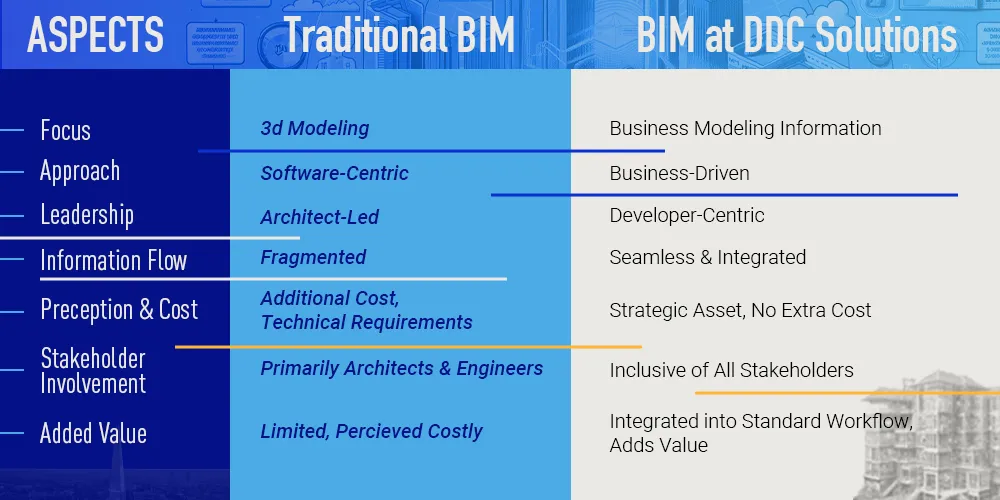
Leveraging BIM for Small Scale Construction Projects
When it comes to the value that projects get out of Building Information Modelling (BIM), small-scale projects top the list. BIM for small projects has significantly improved cost management, efficiency, and overall quality.
Before exploring how leveraging digitization in form of BIM can benefit small projects, let’s have a quick peep into DDC’s unique approach to BIM. Under the guidance of the most sought-after BIM expert Jimi Clarke, our UK-based BIM experts have made project delivery cost and time-efficient, ensuring you get the best results without breaking the bank.

We have worked on projects of all sizes and our portfolio speaks volume about the quality of the service and value that our clients get from us. Book your free consultation with us and find out how DDC Solutions can transform your practices by making your practice cost and time efficient.
Now, let’s get back to our main topic to explore benefits of BIM for small-scale projects.
Benefits of BIM for Small-Scale Projects
Small construction projects can reap significant benefits from BIM. Let’s explore how!
1. Cost and Waste Reduction
BIM for small scale projects is nothing short of a revolution. By implementing BIM into your practice, you can significantly reduce your costs and waste.
How exactly? Well, incorporating BIM will significantly improve your design while facilitating better coordination among all stakeholders. BIM empowers your team to create detailed and accurate 3D models to provide stakeholders with the comprehensive view of the project before construction process kicks off. This detailed visualization helps in identifying conflicts and issues early in the design phase. As a result, the need for costly reworks and changes are either fully eliminated or slashed significantly. Thus, BIM empowers your teams to do effective clash detection and make your project cost efficient. Likewise, the same reduces or eliminates delays and keep your project on schedule.
Additionally, BIM enables you to do precise material estimation and planning. This feature of BIM helps you reduce waste directly and significantly. You can derive accurate material quantities through BIM models. This way, you’ll ensure that only necessary materials are ordered and used. This precision vis-à-vis material used cuts down on excess material and directly aligns with sustainable construction practices. By optimizing resource use and reducing waste, your projects can achieve better financial outcomes and contribute to environmental sustainability.
2. Project Coordination and Management
Effective management of information is a necessity for small-scale projects (don’t ever mistake it as option as it will cost you dearly). Resources are limited so there’s no chance of errors that might translate into costly reworks and delays. Through streamlined BIM information management, BIM experts ensure that all stakeholders associated with your project have access to the most recent information. The centralized nature of BIM allows all stakeholders, including architects, engineers, contractors, and clients, to work from a single, integrated model. This integration facilitates better communication and collaboration, ensuring that everyone is on the same page throughout the project lifecycle.
BIM also allows project managers to simulate construction processes. Doing so helps in identifying potential conflict before they arise. Thus, digitization empowers proactive problem-solving, reducing the likelihood of cost and delays.
Another area where BIM excels is storing and managing vast amount of project data. BIM through information management ensures that all project-related information, such as design changes, material specifications, and construction schedules, is readily accessible. When you have this sort of transparency, it means there will be less room for misunderstandings and miscommunications, keeping setbacks at bay.
3. Standardization and Compliance
When you implement BIM into your practice, you ensure compliance under stringent standards such as ISO 19650. Compliance with industry best practices not only make your practice more reliable but also build trust in front of potential clients. Standardization involves several aspects such as naming convention, responsibility matrices, and BIM Execution Plan aimed at streamlining all processes and improving project outcomes. Adherence to these established standards mean you are consistently achieving a higher level of quality and the same helps you win other projects with ease.
ISO-19650 provides a framework for managing information throughout the lifecycle of a built asset using BIM. The same outlines the best practices such as how to structure and share data throughout the project lifecycle. For small projects, following these standards mean a clear and consistent approach is maintained to project documentation. Besides ensuring compliance, doing this means there are stern checks in place and your project meets and exceeds standards.
4. Enhanced Design Visualization
When it comes to construction projects, detailed visualization is indispensable. BIM excels here as it provides all stakeholders with detailed 3D visualization of the project. From providing detailed BIM visualization to identify conflicts in design phase to simulating the construction processes to select the most optimized approach, BIM ensures that you carry construction activities with utmost efficiency and accuracy.
DDC Solutions – BIM That Is Cost & Time-Efficient
Here at DDC Solutions, our approach to BIM is different. We put less focus on meeting all these fancy acronyms and more on ensuring that BIM is incorporated into your practice in a manner that makes project delivery cost and time-efficient while ensuring strict compliance to all stringent set of standards.
One of the key factors that prevents small practices from incorporating BIM into their practice is cost. And to some extent, their concern is justified as traditional BIM is costly and offer limited added value. However, our BIM experts integrate BIM into your standard workflows ensuring it enhances value at every step of the project. We turn BIM into a strategic asset that adds value without inflating your budget. Book your free consultation to talk to our experts or to get a no-obligation quote for your project! At DDC Solutions, we don’t just sign agreements, we build relations by providing unrivalled BIM solutions.


One Response